Probabilistic Analysis of Shield Tunnel Responses to Surface Surcharge Considering Subgrade Nonlinearity and Variability
Abstract
1. Introduction
2. Deterministic Model for Predicting Tunnel Responses
2.1. Statement of the Problem
2.2. Improved Soil–Tunnel Interaction Model
2.3. Solution of the Analytical Model
- (1)
- Determine the related parameters, such as , , , , , , , , and ;
- (2)
- Determine the calculation domain and evaluate the additional load induced by surface surcharge using Equations (1) and (2);
- (3)
- Set initial approximations of nodal displacements, i.e., , and for convenience, the initial condition of the iteration can be set as ;
- (4)
- Calculate the nonlinear function and its Jacobian matrix using Equations (20) and (24), respectively;
- (5)
- Solve the increment of nodal displacements using Equation (27);
- (6)
- Substitute into Equation (28) and obtain the initial values of nodal displacements in the next iteration;
- (7)
- Evaluate the nodal force residual and the iterative error using Equations (29) and (30), respectively;
- (8)
- If the iterative error is smaller than the allowed tolerance (e.g., ), the obtained values of in the current iteration step are considered to be the tunnel deformation induced by the surcharge. If not, steps (4) to (7) should be repeated until the convergence criterion is reached.
2.4. Recommendation for Related Parameters
2.4.1. Subgrade Parameters
2.4.2. Longitudinal Equivalent Bending Stiffness of Shield Tunnels
3. Probabilistic Analysis Method
3.1. Random Field Model of Subgrade Variability
3.2. Reliability Evaluation Based on Monte Carlo Method
3.3. Procedure of the Probabilistic Analysis Method
4. Illustrative Example
4.1. Presentation of the Investigated Case
4.2. Probabilistic Analysis Results
5. Discussion
5.1. Influences of Subgrade Variability
5.2. Influences of Surcharge Loading Conditions
5.3. Influences of Burial Depth of the Tunnel
6. Conclusions
- An improved soil–tunnel interaction model is developed to assess the longitudinal responses of a shield tunnel under surface surcharge loading, incorporating both the nonlinearity and spatial variability of the subgrade. The Newton–Raphson iterative algorithm is applied to solve the nonlinear equations, in conjunction with the derived finite difference solutions.
- A probabilistic-based analysis method for performing failure risk analysis of a tunnel subjected to surcharge is proposed, where the established soil–tunnel interaction model is treated as deterministic model to acquire the tunnel responses, and the random field theory is introduced to realize the spatial variabilities of subgrade along the longitudinal direction of the tunnel.
- The proposed probabilistic-based method is applied in a historical case from Shanghai Metro Line 9 to evaluate the failure risk of a shield tunnel subjected to surface surcharge. The results indicate that the predicted tunnel settlement considering the subgrade nonlinearity is closer to the measurements compared with the results provided by the linear foundation model; thereby, the advantage of the proposed nonlinear soil–tunnel interaction model is proved.
- The probabilistic results demonstrate that the influence of spatial variability of subgrade parameters on tunnel responses is non-negligible. Within the proposed probabilistic analysis framework, the assessment upon the opening of the circumferential joint produces the lowest failure probability of the tunnel, whereas longitudinal curvature radius-based analysis generates the highest failure risk, and longitudinal settlement-based evaluation yields an intermediate failure probability.
- The stronger the uncertainty of subgrade parameters, the higher the failure risk of the shield tunnel subjected to surcharge. Compared with the influence of the variability of the ultimate reaction of the subgrade, the influence of the uncertainty of subgrade initial stiffness on the tunnel failure risk is more obvious. An increase in the surcharge area significantly elevates the failure probability of existing tunnels. Furthermore, variations in surcharge length demonstrate a more substantial influence on tunnel stability than corresponding changes in surcharge width. As tunnel depth increases, the risk of failure under surcharge loading progressively diminishes.
Author Contributions
Funding
Data Availability Statement
Conflicts of Interest
References
- Liu, J.; Shi, C.; Gong, C.; Lei, M.; Wang, Z.; Peng, Z.; Cao, C. Investigation of ultimate bearing capacity of shield tunnel based on concrete damage model. Tunn. Undergr. Space Technol. 2022, 125, 104510. [Google Scholar] [CrossRef]
- Liu, J.; Shi, C.; Lei, M.; Wang, Z.; Cao, C.; Lin, Y. A study on damage mechanism modelling of shield tunnel under unloading based on damage-plasticity model of concrete. Eng. Fail. Anal. 2021, 123, 105261. [Google Scholar] [CrossRef]
- Huang, L.; Ma, J.; Lei, M.; Liu, L.; Lin, Y.; Zhang, Z. Soil-water inrush induced shield tunnel lining damage and its stabilization: A case study. Tunn. Undergr. Space Technol. 2020, 97, 103290. [Google Scholar] [CrossRef]
- Liang, R.; Wu, J.; Sun, L.; Shen, W.; Wu, W. Performances of adjacent metro structures due to zoned excavation of a large-scale basement in soft ground. Tunn. Undergr. Space Technol. 2021, 117, 104123. [Google Scholar] [CrossRef]
- Lin, Y.; Lai, Z.; Ma, J.; Huang, L.; Lei, M. A FDEM approach to study mechanical and fracturing responses of geo-materials with high inclusion contents using a novel reconstruction strategy. Eng. Fract. Mech. 2023, 282, 109171. [Google Scholar] [CrossRef]
- Lin, Y.; Lai, Z.; Ma, J.; Huang, L. A Combined weighted Voronoi tessellation and random field approach for modeling heterogeneous rocks with correlated grain structure. Constr. Build. Mater. 2024, 416, 135228. [Google Scholar] [CrossRef]
- Zhang, J.; Huang, H.; Zhang, D.; Zhou, M.; Tang, C.; Liu, D. Effect of ground surface surcharge on deformational performance of tunnel in spatially variable soil. Comput. Geotech. 2021, 136, 104229. [Google Scholar] [CrossRef]
- Zhang, J.; Duan, X.; Zhang, D.; Zhai, W.; Huang, H. Probabilistic performance assessment of shield tunnels subjected to accidental surcharges. Struct. Infrastruct. Eng. 2019, 15, 1500–1509. [Google Scholar] [CrossRef]
- Zhang, J.; Huang, H.; Zhang, D.; Phoon, K.K. Experimental study of the coupling effect on segmental shield tunnel lining under surcharge loading and excavation unloading. Tunn. Undergr. Space Technol. 2023, 140, 105199. [Google Scholar] [CrossRef]
- Fan, Y.; Guo, X.; Deng, Z.; Xu, Y. Deformation analysis of shield tunnel with loading and unloading above. Constr. Technol. 2014, 43, 107–109. [Google Scholar]
- Huang, H.; Shao, H.; Zhang, D.; Wang, F. Deformational responses of operated shield tunnel to extreme surcharge: A case study. Struct. Infrastruct. Eng. 2017, 13, 345–360. [Google Scholar] [CrossRef]
- Liu, T.; Chen, S.; Ye, Z. Analysis of disease and structural safety of shield tunnel under accidental surface surcharge. J. Railw. Eng. Soc. 2019, 36, 67–73. [Google Scholar]
- Ding, Z.; Zhang, X.; He, S.; Qi, Y.; Lin, C. Experimental and theoretical study on longitudinal deformation and internal force of shield tunnel under surcharge. Tunn. Undergr. Space Technol. 2024, 144, 105506. [Google Scholar] [CrossRef]
- Liang, R.; Cao, S.; Xiang, L.; Kang, C.; Chen, F.; Li, Z.; Ke, Z.; Guo, Y. Experimental investigation on longitudinal mechanical mechanism of shield tunnels subjected to ground surface surcharge. Chin. J. Rock Mech. Eng. 2023, 42, 736–747. [Google Scholar]
- Wei, G.; Zhang, S.; Xiang, P. Model test study on the influence of ground surcharges on the deformation of shield tunnels. Symmetry 2021, 13, 1565. [Google Scholar] [CrossRef]
- Xiang, P.; Wei, G.; Zhang, S.; Cui, Y.; Guo, H. Model test on the influence of surcharge, unloading and excavation of soft clay soils on shield tunnels. Symmetry 2021, 13, 2020. [Google Scholar] [CrossRef]
- Liu, T.; Xiao, J.; Luo, L. Failure mechanisms of a shield tunnel in composite strata under surface surcharge: Physical model tests and numerical simulations. Int. J. Civ. Eng. 2025, 23, 869–884. [Google Scholar] [CrossRef]
- Huang, Z.; Zhang, H.; Fu, H.; Ma, S.; Liu, Y. Deformation response induced by surcharge loading above shallow shield tunnels in soft soil. KSCE J. Civ. Eng. 2020, 24, 2533–2545. [Google Scholar] [CrossRef]
- Li, Z.; Liu, X.; Wang, J. Elaborate numerical investigation on surcharge-induced mechanical responses and strengthening effects of single-line shield tunnels with typical cross-sections. Tunn. Undergr. Space Technol. 2025, 156, 106237. [Google Scholar] [CrossRef]
- Ruan, H.; Liang, R.; Kang, C.; Li, Z.; Ke, Z. Three-dimensional elaborate numerical modelling analysis on the deformation mechanism of metro shield tunnel induced by sudden surface surcharge. Saf. Environ. Eng. 2023, 30, 35–45+77. [Google Scholar]
- Cao, S.; Liang, R.; Kang, C.; Wu, W.; Ke, Z.; Guo, Y. Analytical prediction for longitudinal deformation of shield tunnel subjected to ground surface surcharge considering the stiffness reduction. Int. J. Numer. Anal. Methods Geomech. 2024, 48, 925–950. [Google Scholar] [CrossRef]
- Kang, C.; Mei, G.; Liang, R.; Wu, W.; Fang, Y.; Ke, Z. Analysis of the longitudinal deformation of existing shield tunnel induced by temporary surface surcharge. Rock Soil Mech. 2018, 39, 4605–4616. [Google Scholar]
- Wei, G.; Yu, G.; Hong, W. Study on calculation of shield tunnel shearing dislocation platform deformation due to adjacent ground stacked load. J. Cent. South Univ. (Sci. Technol.) 2018, 49, 1775–1783. [Google Scholar]
- Wei, Z.; Jiang, Y. A simplified analysis method for the deformation response of an existing tunnel to ground surcharge based on the pasternak model. Appl. Sci. 2021, 11, 3255. [Google Scholar] [CrossRef]
- Zhang, Z.; Huang, M.; Pan, Y.; Jiang, K.; Li, Z.; Ma, S.; Zhang, Y. Analytical prediction of time-dependent behavior for tunneling-induced ground movements and stresses subjected to surcharge loading based on rheological mechanics. Comput. Geotech. 2021, 129, 103858. [Google Scholar] [CrossRef]
- Wu, H.; Shen, S.; Yang, J.; Zhou, A. Soil-tunnel interaction modelling for shield tunnels considering shearing dislocation in longitudinal joints. Tunn. Undergr. Space Technol. 2018, 78, 168–177. [Google Scholar] [CrossRef]
- Liang, R. Simplified analytical method for evaluating the effects of overcrossing tunnelling on existing shield tunnels using the nonlinear pasternak foundation model. Soils Found. 2019, 59, 1711–1727. [Google Scholar] [CrossRef]
- Liang, F.; Jiang, Z.; Yuan, Q.; Li, L.; Wang, R. Time-dependent longitudinal responses of a shield tunnel induced by surcharge load: Theoretical prediction and analysis. Undergr. Space 2024, 14, 219–238. [Google Scholar] [CrossRef]
- Wang, Z.; Shi, C.; Gong, C.; Lei, M.; Liu, J.; Cao, C. An enhanced analytical model for predicting the nonlinear longitudinal equivalent bending stiffness of shield tunnels incorporating combined n-m actions. Tunn. Undergr. Space Technol. 2022, 126, 104567. [Google Scholar] [CrossRef]
- Zhang, Z.; Zheng, G.; Cheng, X.; Liang, R.; Li, C.; Zhong, Z.; Zhao, J. Analytical approach for longitudinal deformation of shield tunnels considering bending-shear-torsional effects of circumferential joints. Tunn. Undergr. Space Technol. 2024, 152, 105946. [Google Scholar] [CrossRef]
- Wang, Z.; Shi, C.; Gong, C.; Cao, C.; Peng, Z.; Sun, Y. Difference solutions for responses of foundation-beams with arbitrary boundary conditions considering spatial soil variability and its applications. Comput. Geotech. 2022, 151, 105002. [Google Scholar] [CrossRef]
- Wang, Z.; Shi, C.; Chen, H.; Peng, Z.; Sun, Y.; Zheng, X. Probabilistic analysis of the longitudinal performance of shield tunnels based on a simplified finite element procedure and its surrogate model considering spatial soil variability. Comput. Geotech. 2023, 162, 105662. [Google Scholar] [CrossRef]
- Ghazavi, M.; Mahmoodi, E.; El Naggar, H. Load-deflection analysis of laterally loaded piles in unsaturated soils. Acta Geotech. 2023, 18, 2217–2238. [Google Scholar] [CrossRef]
- Lin, C.; Wang, Z.; Liu, Z.; Luo, X.; Ma, B.; Chen, Y. Tunnelling-induced nonlinear responses of continuous pipelines resting on tensionless winkler foundation. Transp. Geotech. 2024, 49, 101386. [Google Scholar] [CrossRef]
- Pejman, M.; Habibagahi, G.; Veiskarami, M. Response of buried pipelines subjected to ground subsidence using a nonlinear pasternak approach. Transp. Geotech. 2025, 51, 101504. [Google Scholar] [CrossRef]
- Zhao, C.; Gong, W.; Juang, C.H.; Tang, H.; Liu, Z.; Hu, X. Probabilistic performance analysis of longitudinal tunnels based on coupled characterization of stratigraphic and geo-properties uncertainties. Tunn. Undergr. Space Technol. 2025, 161, 106552. [Google Scholar] [CrossRef]
- Jiang, Q.; Zhang, J.; Zhang, D.; Huang, H.; Shi, J.; Li, Z. Influence of geological uncertainty on longitudinal deformation of tunnel based on improved coupled markov chain. Eng. Geol. 2024, 337, 107564. [Google Scholar] [CrossRef]
- Huang, H.W.; Xiao, L.; Zhang, D.M.; Zhang, J. Influence of spatial variability of soil young’s modulus on tunnel convergence in soft soils. Eng. Geol. 2017, 228, 357–370. [Google Scholar] [CrossRef]
- Wang, Z.; Shi, C.; Chen, H.; Lei, M. Probabilistic evaluation for excavation-induced longitudinal responses of existing shield tunnel in spatially random soils. Comput. Geotech. 2024, 167, 106110. [Google Scholar] [CrossRef]
- Peng, Z.; Shi, C.; Wang, Z.; Lei, M.; Peng, L. Longitudinal structural vulnerability analysis of shield tunnels under adjacent excavation disturbances. J. Cent. South Univ. 2025, 32, 2256–2272. [Google Scholar] [CrossRef]
- Attewell, P.B.; Yeates, J.; Selby, A.R. Soil Movements Induced by Tunnelling and Their Effects on Pipelines and Structures; Methuen, Inc.: New York, NY, USA, 1986. [Google Scholar]
- Shiba, Y.; Kawashima, K.; Obinata, N.; Kano, T. An evaluation method of longitudinal stiffness of shield tunnel linings for application to seismic response analyses. Doboku Gakkai Ronbunshu 1988, 1988, 319–327. [Google Scholar] [CrossRef]



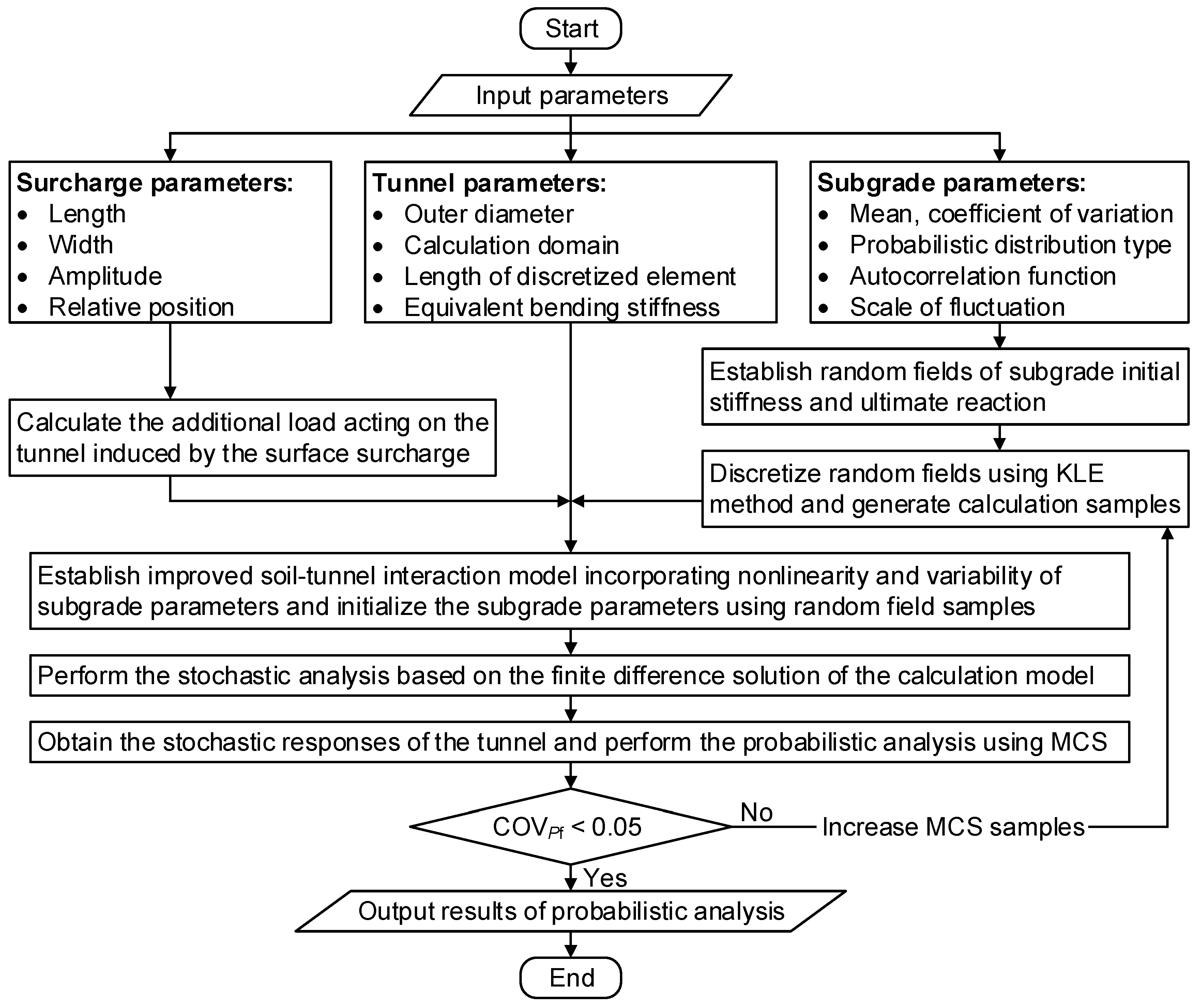
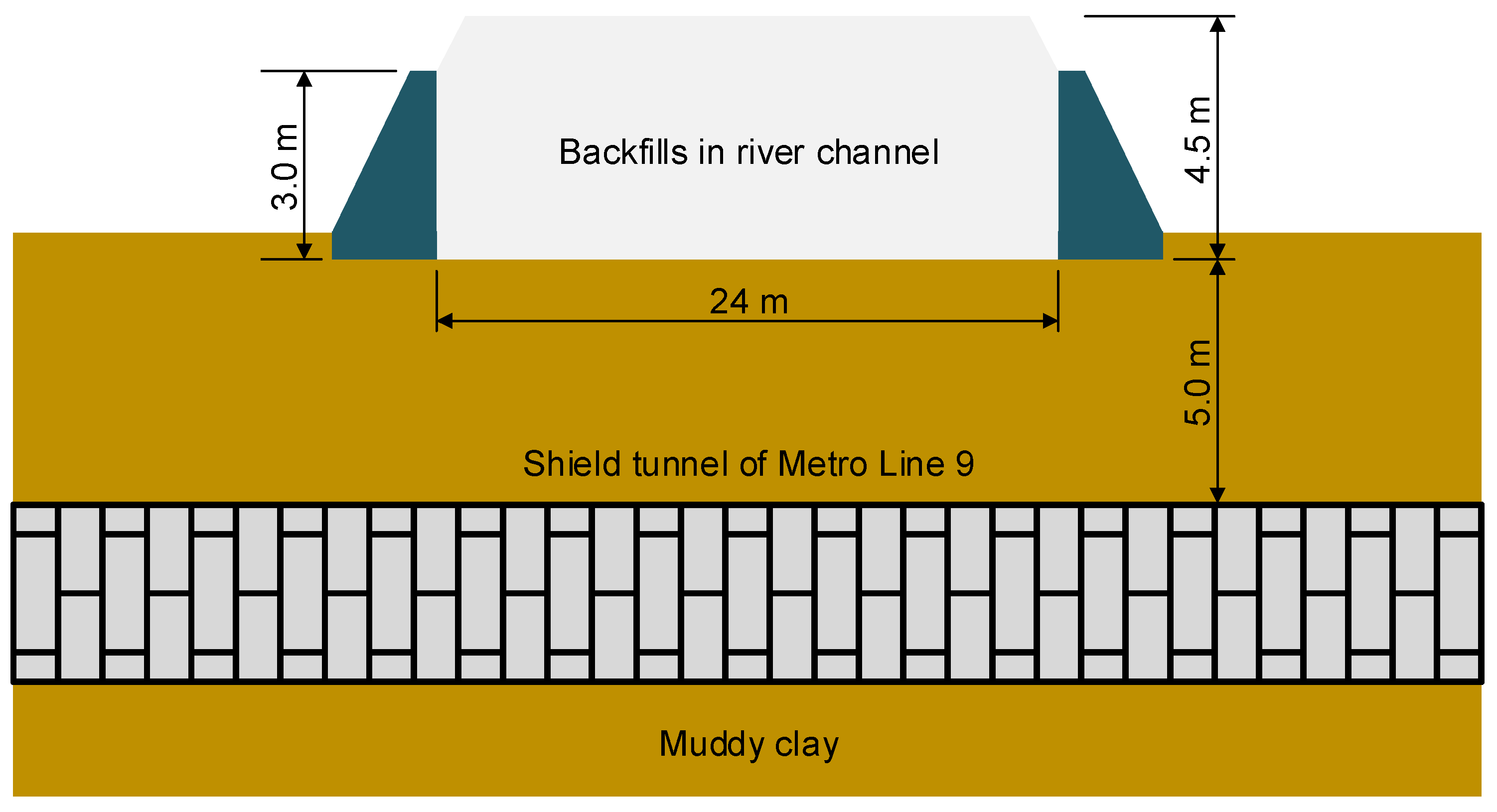
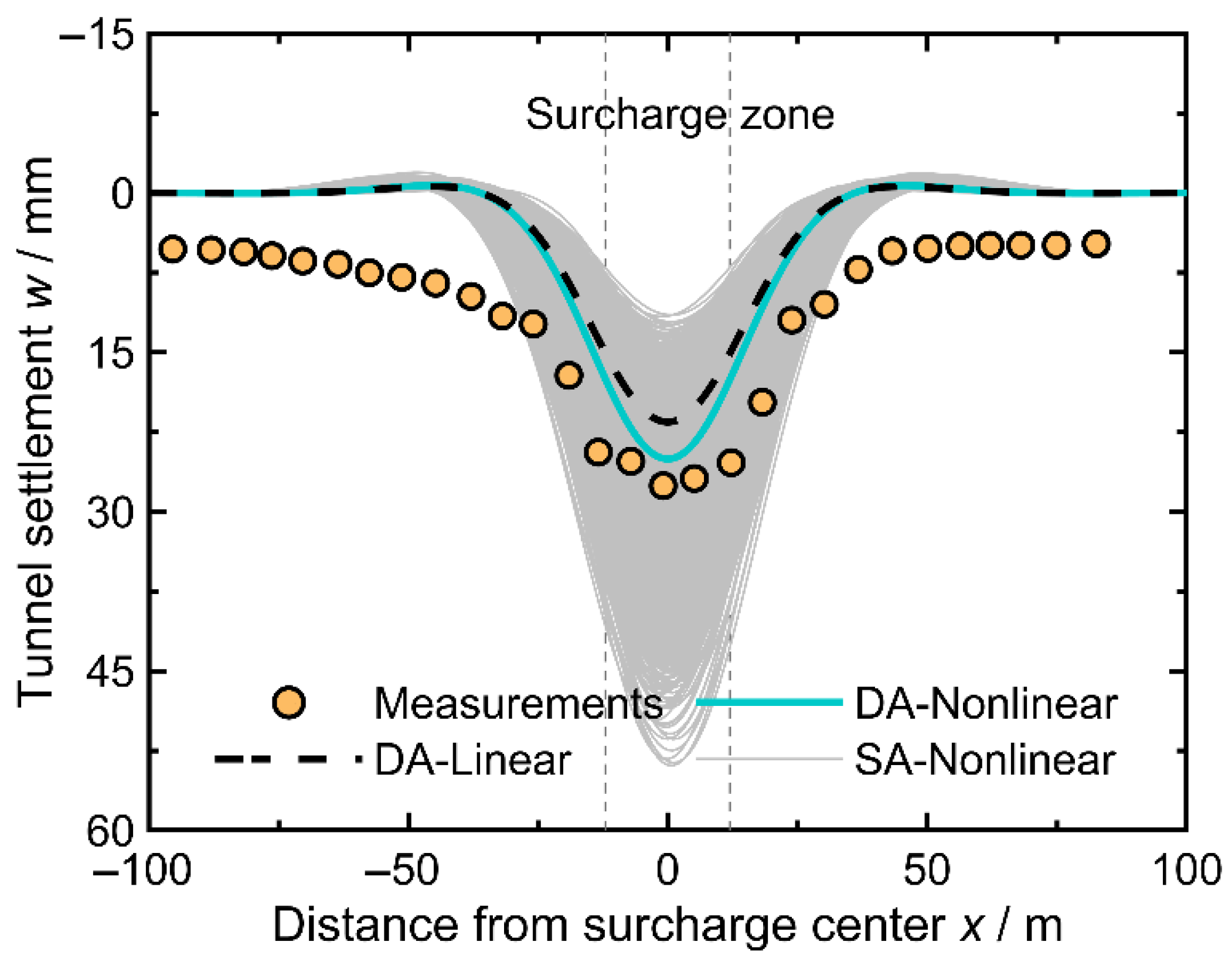
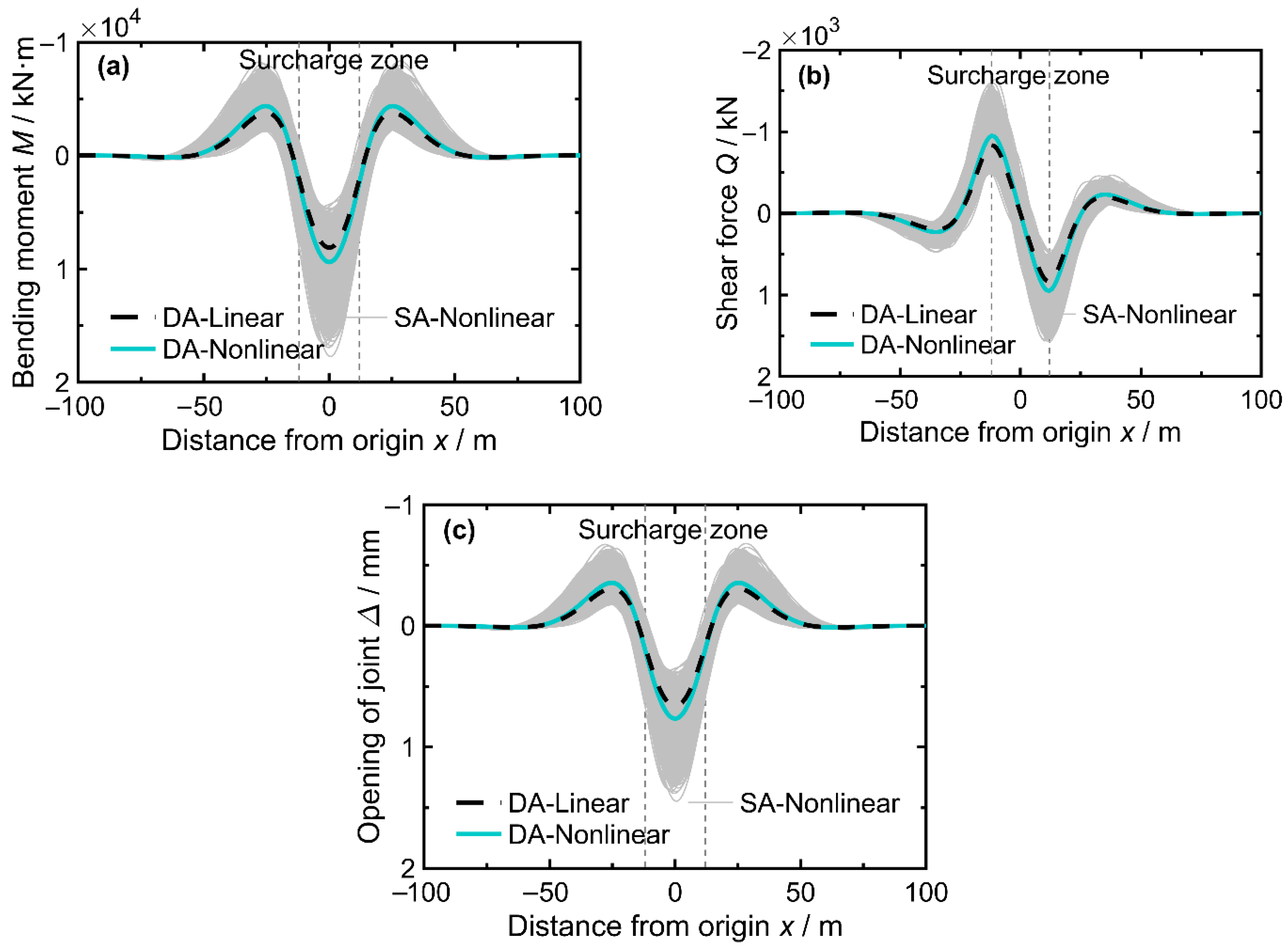

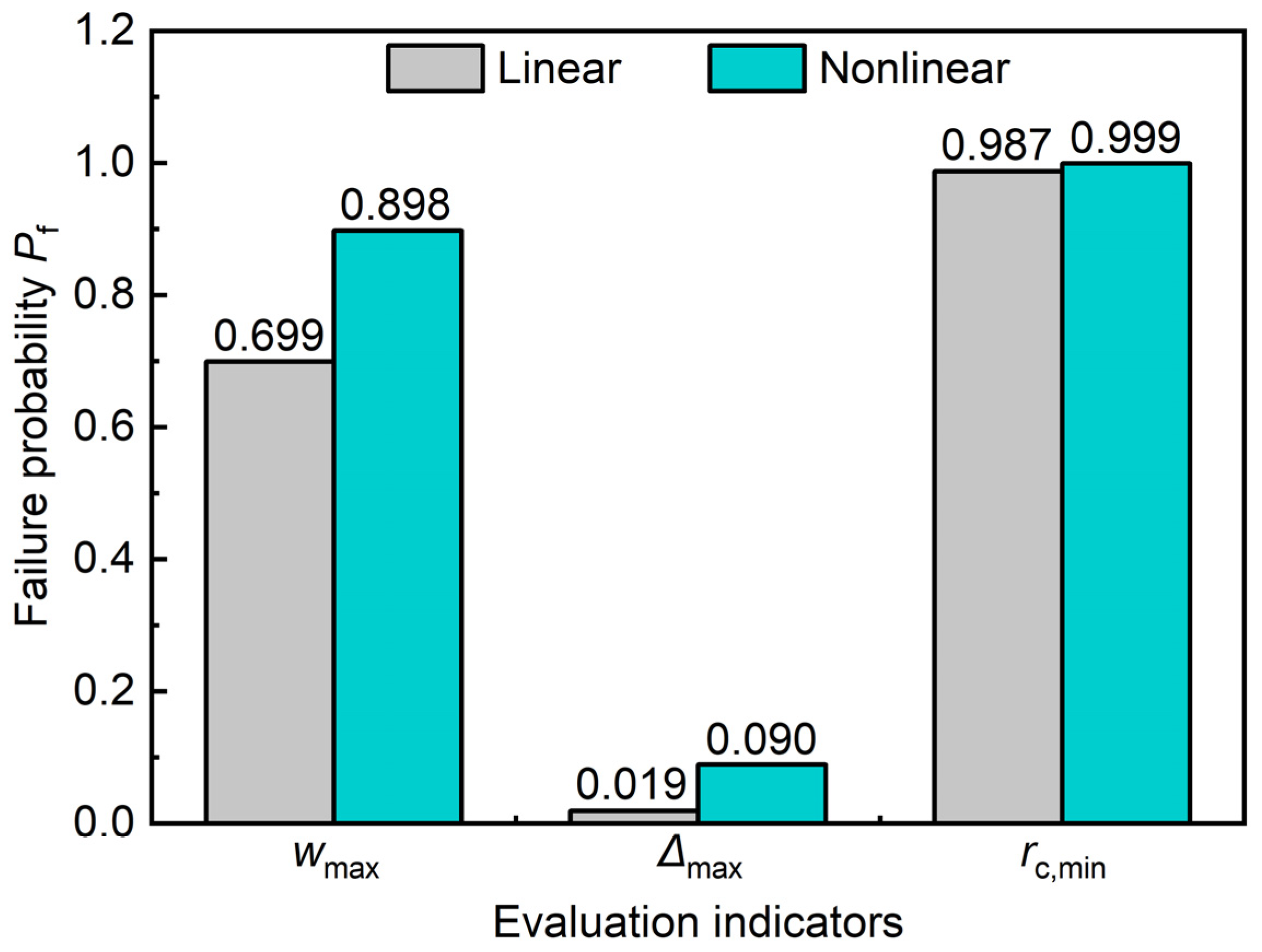

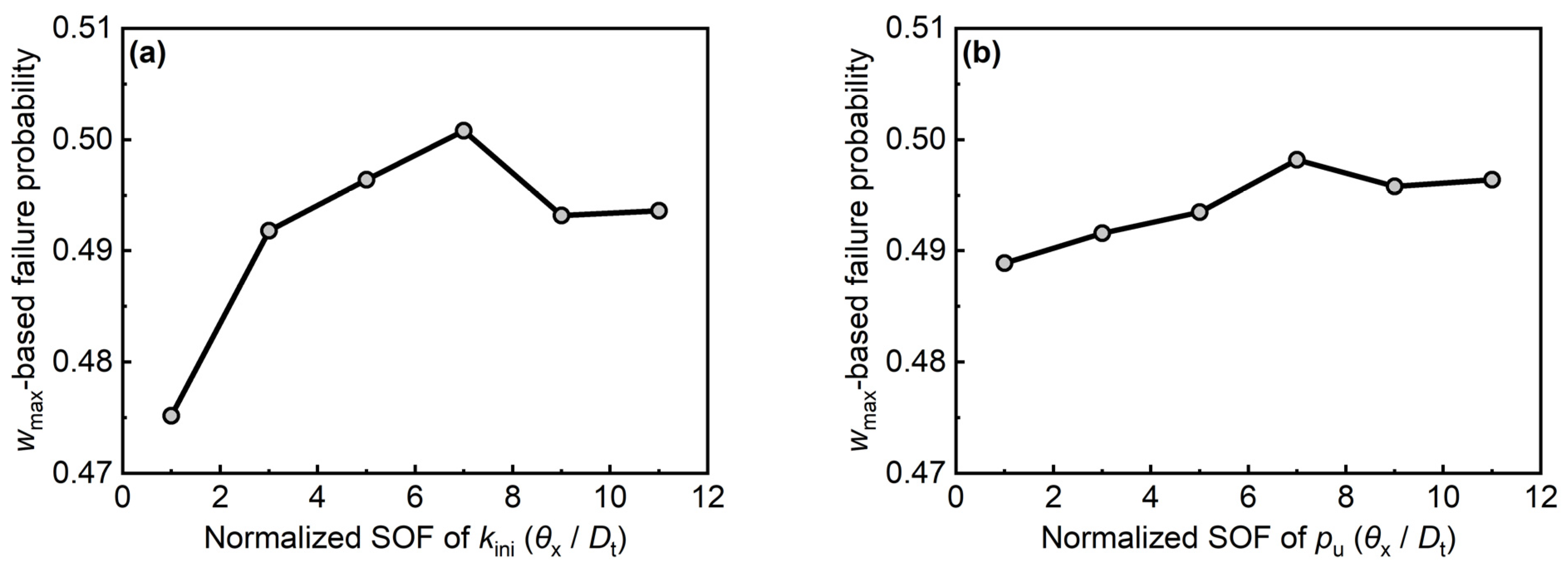
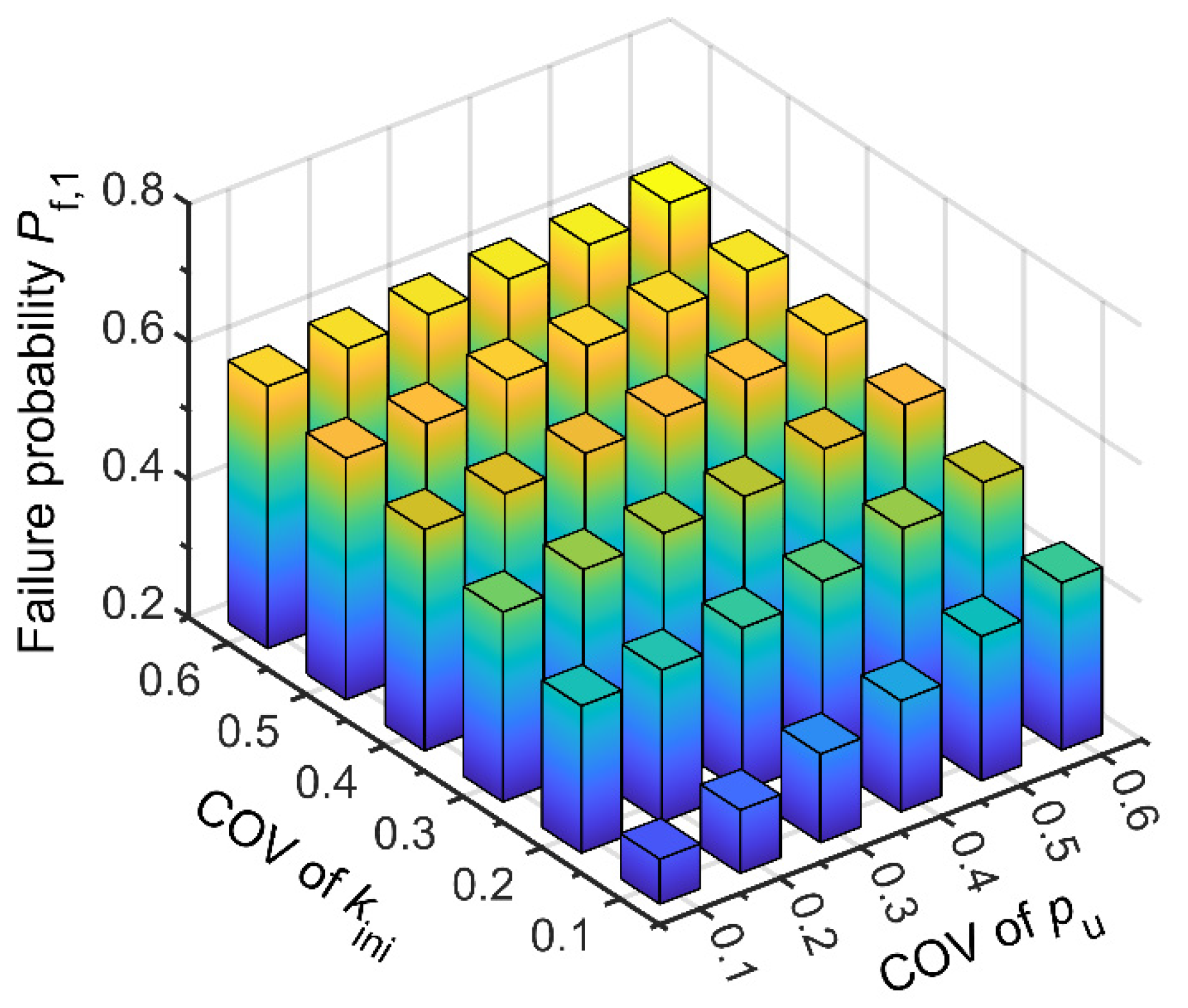
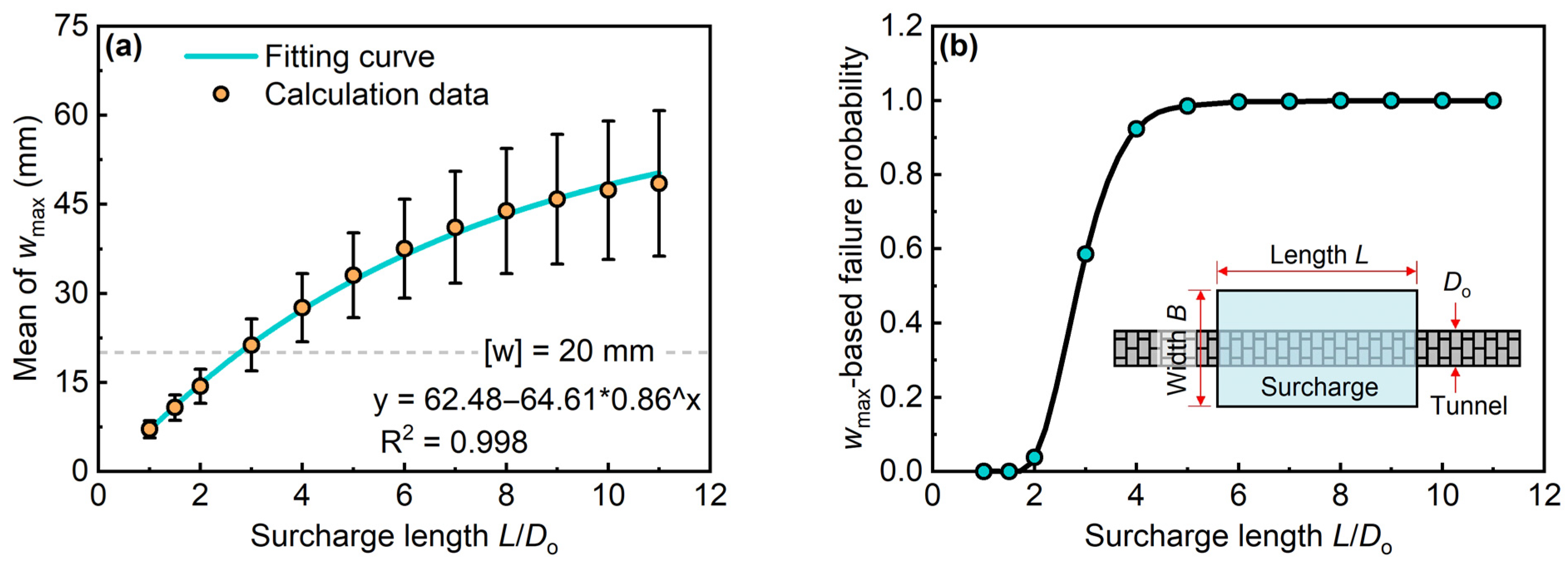
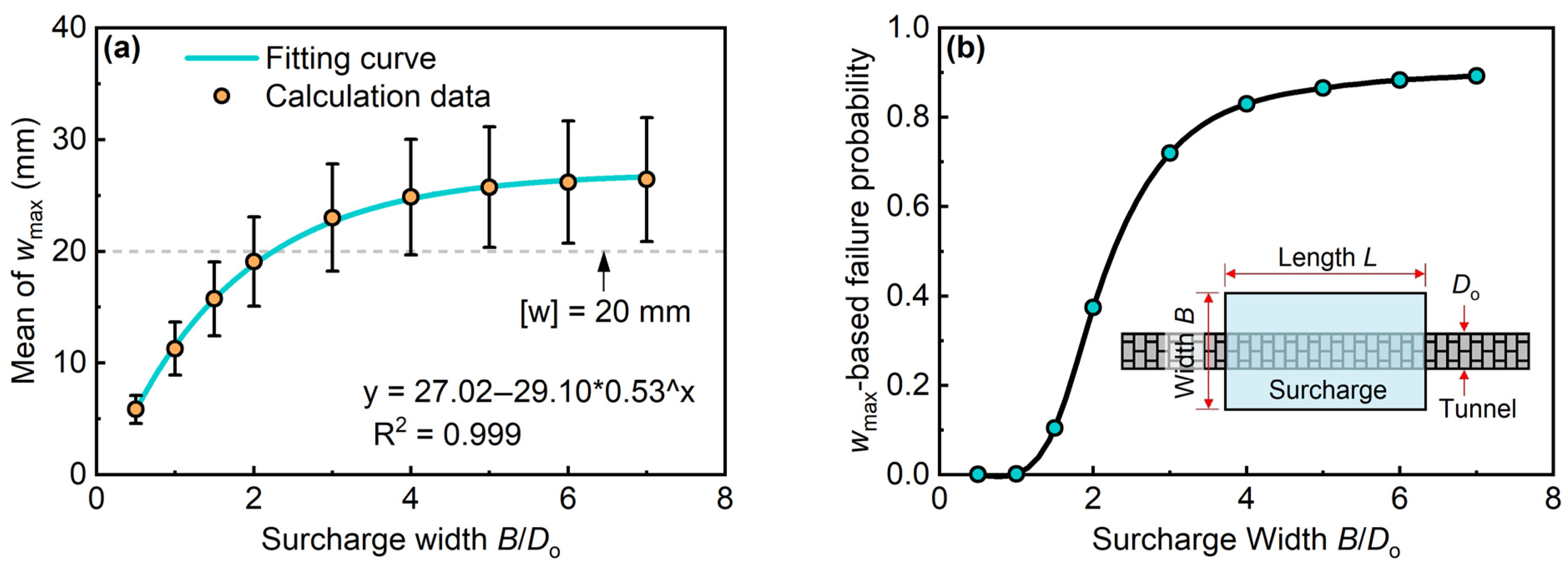
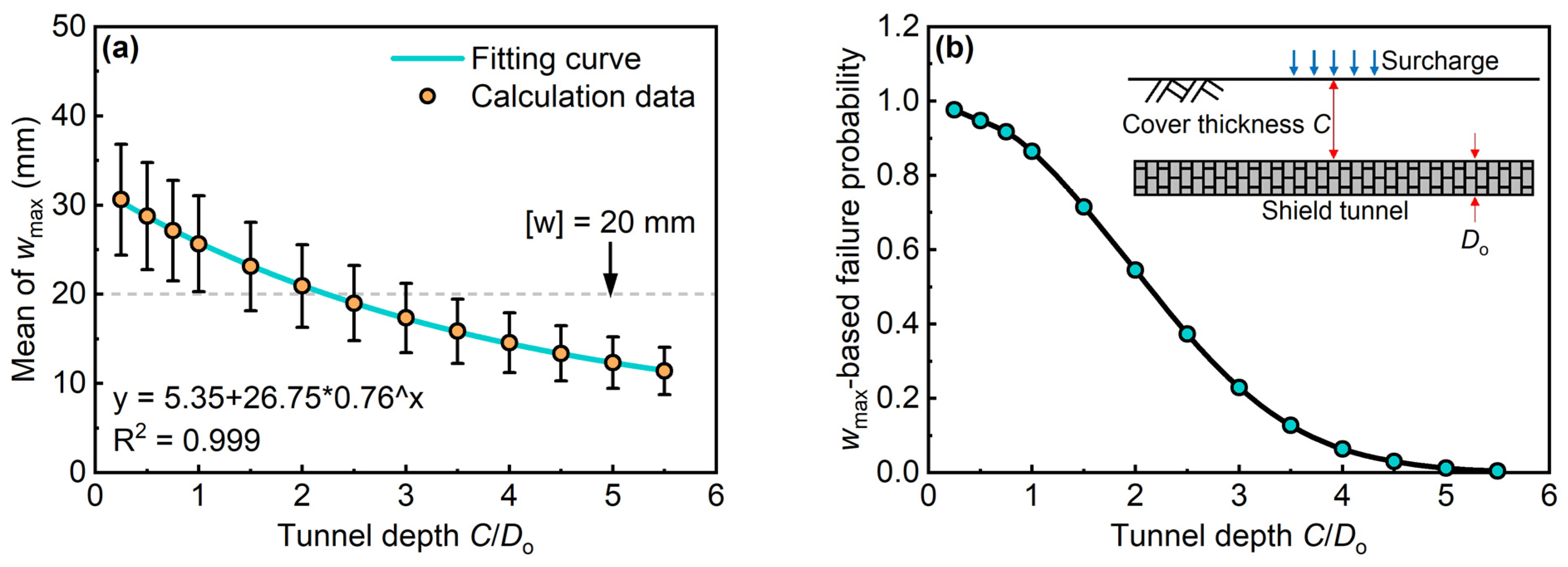
| Assessment Indicators | Threshold Values |
|---|---|
| Longitudinal settlement, (mm) | 20 |
| Opening of the circumferential joint, (mm) | 1.0 |
| Curvature radius of the longitudinal deformation, (m) | 15,000 |
| Segment | Bolt of Circumferential Joint | ||
|---|---|---|---|
| Outer diameter (m) | 6.2 | Number | 17 |
| Thickness (m) | 0.35 | Diameter (mm) | 30 |
| Width (m) | 1.2 | Length (mm) | 400 |
| Young’s modulus (kPa) | 3.45 × 107 | Young’s modulus (kPa) | 2.06 × 108 |
| Poisson’s ratio | 0.2 | Poisson’s ratio | 0.3 |
Disclaimer/Publisher’s Note: The statements, opinions and data contained in all publications are solely those of the individual author(s) and contributor(s) and not of MDPI and/or the editor(s). MDPI and/or the editor(s) disclaim responsibility for any injury to people or property resulting from any ideas, methods, instructions or products referred to in the content. |
© 2025 by the authors. Licensee MDPI, Basel, Switzerland. This article is an open access article distributed under the terms and conditions of the Creative Commons Attribution (CC BY) license (https://creativecommons.org/licenses/by/4.0/).
Share and Cite
Song, P.; Xu, Z.; Wang, Z.; Lin, Y. Probabilistic Analysis of Shield Tunnel Responses to Surface Surcharge Considering Subgrade Nonlinearity and Variability. Mathematics 2025, 13, 2620. https://doi.org/10.3390/math13162620
Song P, Xu Z, Wang Z, Lin Y. Probabilistic Analysis of Shield Tunnel Responses to Surface Surcharge Considering Subgrade Nonlinearity and Variability. Mathematics. 2025; 13(16):2620. https://doi.org/10.3390/math13162620
Chicago/Turabian StyleSong, Ping, Zhisheng Xu, Zuxian Wang, and Yuexiang Lin. 2025. "Probabilistic Analysis of Shield Tunnel Responses to Surface Surcharge Considering Subgrade Nonlinearity and Variability" Mathematics 13, no. 16: 2620. https://doi.org/10.3390/math13162620
APA StyleSong, P., Xu, Z., Wang, Z., & Lin, Y. (2025). Probabilistic Analysis of Shield Tunnel Responses to Surface Surcharge Considering Subgrade Nonlinearity and Variability. Mathematics, 13(16), 2620. https://doi.org/10.3390/math13162620






